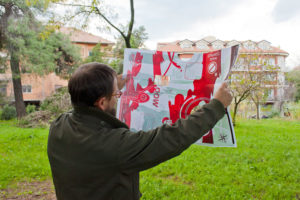Public parks promise public life: hanging out with or without purpose, meeting or observing strangers and socializing. In our research we locate this publicness in what we call intimate encounters. Intimacy is always already a social condition: the social condition of leaving “home”, which is the privileged place of intimacy as protected being-in-oneself. The home is that comfort zone in which we experience the world as a domesticated, routinized, familiar place. Leaving the home/comfort zone towards an engagement with the Other is thus the moment of becoming public, a moment which we call an intimate encounter. We assume that it is such intimate encounters through which publicness is produced.
For Exploded View at the Amstelpark and the Via Appia Park, we will further unpack publicness as a productive process by making memories and meanings of the parks tangible. We will create moments of shared intimacy, furthering the transgression of boundaries between humans, things, spatial arrangements, plants and animals.
To do so, we collectively develop a research instrument that stimulates these encounters. During Exploded View we are developing a mobile research practice that triggers processes of disorientation while questioning prefigured spatial orders and borders. Our research tool is inspired by what we know as a classical map – a two-dimensional, double-sided carton/thick paper, i.e. in A1-format, foldable, and colored. Although our ‘map’ does not claim to represent space in a universal manner, it shares some of the key characteristics of a map: the tool may serve as an analytical instrument. One can ask a map about the location of things and discover one’s location as well as what direction one should move in to reach a goal. A map is thus a tool to experience space. One can measure, seize, and engage with its represented spaces while it remains functional to assist in a users’ orientation.
Our tool is dynamic and undermining those central functions of a classical map. As our main research tool, the “map”, is under constant, dynamic and procedural development. It allows us to de-orient ourselves in the urban park in ways that facilitate our immersion into this socio-material organism. Both product and productive element, the map becomes a responsive medium by which research participants may engage, or immerse, in encounters and interactions. The map triggers auditive, haptic, visual, and olfactory experiences. While we use the map we adopt it to our individual or collective ways of experiencing space, yet the tool is also a topo itself: a place in which we act and which is being transformed by our presence and interaction.
During the research period of Exploded View, together with a few research participants, we collectively test and develop the map. Together we explore how the map can be used to transgress the boundaries of the self and the other in the intimacy of encounters between humans, things, spatial arrangements, plants and animals.

